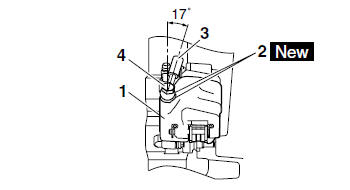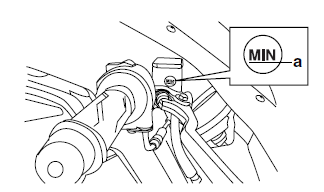Yamaha YZF-R125 Service Manual: Installing the front brake caliper
1. Install:
- Brake caliper "1" (temporarily)
- Copper washers "2"

- Brake hose "3"
- Brake hose union bolt "4"

| WARNING Proper brake hose routing is essential to insure safe vehicle operation. Refer to "CABLE ROUTING" on page 2-33. |
CAUTION:
|

2. Remove:
- Brake caliper
3. Install:
- Brake pad spring
- Brake pads
- Brake caliper
- Brake hose holder

Refer to "REPLACING THE FRONT BRAKE PADS" on page 4-22.
4. Fill:
- Brake master cylinder reservoir
(with the specified amount of the recommended
brake fluid)

WARNING
|
| CAUTION: Brake fluid may damage painted surfaces and plastic parts. Therefore, always clean up any spilt brake fluid immediately. |
5. Bleed:
- Brake system Refer to "BLEEDING THE HYDRAULIC BRAKE SYSTEM" on page 3-20.
6. Check:
- Brake fluid level
Below the minimum level mark "a"

Add the recommended brake fluid to the proper level.Refer to "CHECKING THE BRAKE FLUID LEVEL" on page 3-18.

7. Check:
Brake lever operation Soft or spongy feeling → Bleed the brake system.
Refer to "BLEEDING THE HYDRAULIC BRAKE SYSTEM" on page 3-20.
 Assembling the front brake caliper
Assembling the front brake caliper
WARNING
Before installation, all internal brake components
should be cleaned and lubricated
with clean or new brake fluid.
Never use solvents on internal brake components
as ...
 Removing the front brake master cylinder
Removing the front brake master cylinder
NOTE:
Before removing the front brake master cylinder,
drain the brake fluid from the entire brake system.
1. Disconnect:
Front brake light switch
2. Remove:
Brake hose union bolt
Copp ...
Other materials:
Periodic maintenance and adjustment
Periodic inspection, adjustment, and lubrication
will keep your vehicle in the
safest and most efficient condition possible.
Safety is an obligation of the vehicle
owner/operator. The most important
points of vehicle inspection, adjustment,
and lubrication are explained on
the followin ...
Adjusting the throttle cable free play
Throttle cable free play
The throttle cable free play should measure
3.0-5.0 mm (0.12-0.20 in) at the
throttle grip. Periodically check the
throttle cable free play and, if necessary,
adjust it as follows.
TIP
The engine idling speed must be correctly
adjusted before checkin ...
Installing the starter clutch
1. Install:
Starter clutch assembly
Starter clutch bolts "1"
NOTE:
While holding the generator rotor "2" with the
sheave holder "3", tighten the starter clutch
bolts.
Do not allow the sheave holder to touch the
projection on the generator rotor.
Stake the end "a" of each start ...
